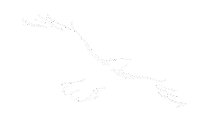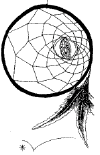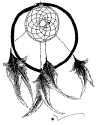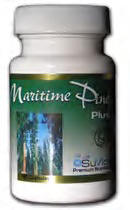When early explorers discovered a vast
new wilderness that one day would be known as North American they also
came upon this continent's first medical team. The inhabitants of the
unexplored land were a race of people distinguished as the North
American Indians. Long before that first contact with the white man
these aboriginal peoples were clever in finding ways to help
themselves.
Physician, surgeon, pharmacist at one and the same time, the
skilled tribal persons operated on the injured, treated disease and effected
cures among their people. The system of medicine, surprisingly complete, was
handed down unwritten from generation to generation.
While remarkably free of disease, Indian people did have
ailments which made it necessary for them to seek curative herbs. The
predominant disorders besides besides external injuries, seem to have been
arthritis digestive disorders and respiratory infections. Apparently the
Native American's generally harmonious quiet way of life, apart from
warfare, protected them from a whole category of the white man's ills. It
seems that heart disease, arteriosclerosis, and cancer were rare indeed.
Neurological and psychiatric disturbances were also uncommon.
Many traditional Native Indian medicines have made their way
into the white man's pharmacopeia; and the active agents of many important
drugs in use today, such as cascara sagrada - presently the most widely used
cathartic in the world - is still widely used in the U.S. Pharmacopeia since
so synthetic substitute has ever been found to replace it. Cascara
sagrada is derived from the bark of the buckthorn tree. This tree was
given the name of the 'sacred bark' by Europeans who were impressed by it's
mildness and efficacy.
It is only in comparatively modern times that some of the
most astonishing Indian early medical knowledge has been uncovered by
scientific investigators. For example, Dr. Frederick Banting, discoverer of
insulin, credited Indian healers with the 'pharmaceutical' spade work which
lead to his discovery.
As a surgeon, how did the North American Indian compare with
his European colleague? Judging by reports of white men, the Indian's
surgical technique for the pruning of a human limb was one of spectacular
skill since successful operations depended on speed. An amputation at the
joint was performed with a knife of flint. Blood vessels were sealed with
stones heated to redness, thus arresting hemorrhage. Deer sinews were used
as sutures. Other materials used in the joining together of two edges of a
wound or incision included human hair, vegetable fibres, and those of the
light, soft, durable, basswood. Excess bleeding was arrested by spider webs
or pulverized puffballs.
With regard to patient-comfort, the aboriginal surgeon knew
a great deal about pain-allaying medicines to put him patient "under". In
fact, as far as anesthetics were concerned, the Indian medical practitioner
was centuries ahead of the European 'conquerors'.
In the treatment of wounds one of the most remarkable
aspects of Indian practice was the use of some form of aseptic technique. It
was the late 19th century before Europeans or white doctors learned the
necessity of keeping wounds clean. One historical report indicates that when
an Indian of the Illinois tribe was wounded by shot or arrow, a quantity of
warm water with diluted drugs was poured into him.
As a bone setter, the North American Indian dexterously and
with care, set fractures of the bones. Splints of cedar were applied, padded
with leaves or grass and then bound with soft, pliable branches of the young
birch. Dislocations were reduced by the simple medium of force.
The sweat bath was also considered an important remedy for
painful conditions of joints and muscles as well as a means of cleanliness.
Again, in contrast to the derogatory disdain with which many white people
viewed Native American life, North America's original inhabitants were
practically 'health nuts' in this respect. Almost all Europeans commented on
the custom of frequent bathing whenever these Indians lived near water.
To rid the body of venom from a reptile or insect bite and
to draw off pus from an infected wound, the healing technique of sucking was
employed rationally and effectively. Treatment included a preliminary does
of snakeroot powder taken by both patient and treatment giver.
In the Indian's pharmaceutical supply of both humble week
and bright flower, roots, herbs, plants, tree barks, even odors served a
medicinal purpose. An example is the powdered roots of buttercups which,
when inhaled, relieved headaches. All medications were stored in skins to
keep them clean and dry.
So far, we have talked about the persons who we would
identify as the 'doctors' in the tribe. What about the 'nurse', the other
half of this first North America Native medical team? She was a woman of the
tribe, gentle and confident in her skills. Hollywood not withstanding, she
did not shake rattles, blow dust, or do weird dances to fight off the
maladies that beset her patient. If she crooned softly while wiping the
perspiration from a fretful patient's brow, she soothed worries as well as
wounds. Observing and charting a patient's progress in her own manner was an
important responsibility. So also was the brewing and making of poultices
and other applications from nature's pharmaceutical array. This latter task
was an art in itself and one of the nurse's duties. An Indian woman's
reliability could be judged by the faithfulness in carrying out orders in
the absence of the healer ('doctor') A patient's life might depend on it.
There were many kinds of wounds to dress, for injuries were
common affairs in the life of hunting and engaging in warfare. But the women
of the tribe treated them all and probably cheered their patients with their
gentle ways.
Almost all the Indian's diseases came about by the weather,
and hardships such as famine and injuries. It was only with the arrival of
the white man that the North American Indian's system of medicine broke
down. New, and to the Native 'doctors' and 'nurses', unknown diseases such
as scarlet fever, tuberculosis, smallpox, and other frightful diseases
spread through the tribes like a devastating flame. It is noted that the
entire western plains region of Canada was ravaged by smallpox in the fall
and winter of the 1870's. An estimated five thousand Cree and Blackfoot
died. The fatal blossoms of smallpox almost decimated the Indian population.
In the providence of God, only the discovery of a vaccination by an English
physician, Edward Jenner, saved the North American inhabitants. In a sense,
western medical science gave back to Native Americans a little of what it
owed.
From the early Indian healer's knife of sharp edged stone to
the contemporary surgeon's steel scalpel and laser surgery has been a long
journey - a journey which has been eased and enriched by contributions from
both societies.






 Maritime
Pine Pycnogenol
Maritime
Pine Pycnogenol
 Get
a course to promote your business online, explode your sales
Get
a course to promote your business online, explode your sales Get
software to promote your business online in less time
Get
software to promote your business online in less time Get
software to streamline your business and run it hands free.
Get
software to streamline your business and run it hands free.